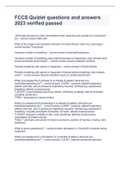FCCS Quizlet questions and answers 2023 verified passed
.What labs should you order immediately when assessing the acutely ill or injured pt? (2) - correct answer ABG, BG
What is the single most important indicator of critical illness? (hint: it's a vital sign) - correct answer Tachypnea
Increase in depth of breathing - correct answer Kussmaul/hyperpnea
Increase in depth of breathing, also called Kussmaul or hyperpnea, may indicate what severe acid/base abnormality? - correct answer severe metabolic acidosis
Periodic breathing with apnea or hypopnea - correct answer Cheyne-Stokes
Periodic breathing with apnea or hypopnea (Cheyne-stokes breathing) may indicate what? - correct answer Severe brainstem injury or cardiac dysfunction
When you assess the A (airway) in a critically ill patient, what are you look/listening/feeling for? - correct answer *LOOK:* cyanosis, altered respiratory pattern and rate, use of accessory respiratory muscles, tracheal tug, paradoxical breathing, altered consciousness
*LISTEN:* noisy breathing (grunting, stridor, wheezing, gurgling); silence indicates complete obstruction
*FEEL:* decreased or absent airflow
When you assess the B (breathing) in a critically ill patient, what are you look/listening/feeling for? - correct answer *LOOK:* cyanosis, altered respiratory pattern and rate, use of accessory respiratory muscles, tracheal tug, paradoxical breathing, *equality and depth of breaths, O2 sats*, altered consciousness
*LISTEN:* dyspnea, inability to talk, noisy breathing, dullness to percussion, auscultation of breath sounds
*FEEL:* symmetry and extent of chest movements, position of trachea, crepitus, abd. distension
What is pulsus paradoxus? - correct answer decrease in >10mmHG in systole during inspiration
When you assess the C (circulation) in a critically ill patient, what are you look/listening/feeling for? - correct answer *LOOK:* reduced peripheral perfusion (pallor) and delayed cap refill, hemorrhage (obvious or concealed), AMS, dyspnea, decreased urine output, jugular venous distension
*LISTEN:* altered heart sounds, carotid bruits
*FEEL:* precordial cardiac pulsation, central and peripheral pulses (assessing rate, quality, regularity, symmetry), cool extremities
How do you intubate in someone with a cervical spine injury? - correct answer Immobilize with C-collar, then elevate mandible/open the mouth
Which airway is not used if airway reflexes are intact, as it may cause gagging/laryngospasm/emesis: nasopharyngeal airway or oropharyngeal airway? - correct answer oropharyngeal airway
Oropharyngeal airway - correct answer a curved device inserted through the patient's mouth into the pharynx to help maintain an open airway
Nasopharyngeal airway - correct answer Airway adjunct inserted into the nostril of an unresponsive patient, or a patient with an altered level of consciousness who is unable to maintain airway patency independently.
When is a nasopharyngeal airway contraindicated? - correct answer -LeFort II or III fracture
-*Basilar skull fracture*
-CSF rhinorrhea
-Raccoon eyes
-Periorbital edema
-*Coagulopathy*
-Previous transsphenoidal hypophysectomy or Caldwell-Luc procedure
MC cause of airway obstruction - correct answer pt's tongue
When is bag mask ventilation indicated? - correct answer Pt apneic
Spontaneous tidal volumes are inadequate
Reduce work of breathing
Hypoxemia is associated with poor spontaneous ventilation
In bag mask ventilation, how many bpm? how long should the breaths be over? - correct answer 10-12 bpms over 1 second for each breath
Risks to too many breaths with bag mask resuscitation? - correct answer hyperventilation
respiratory alkalemia
gastric distension
What % O2 should be delivered in bag mask ventilation? - correct answer 100% Sellick maneuver - correct answer cricoid pressure
Indications for tracheal intubation - correct answer airway protection
relief of obstruction
provision of mechanical ventilator and O2 therapy
respiratory failure
shock
hyperventilation
reduction of the work of breathing
facilitation of suctioning/pulmonary toilet
Maximum lidocaine dose - correct answer 300mg
Name the NMBs used for intubation - correct answer succinylcholine
vecuronium/rocuronium/cisatracurium
Which NMB will you see fasciculations with? - correct answer succinylcholine
When is succinylcholine contraindicated? - correct answer ocular injury, head injury, hyperkalemia, burn/crush/rhabdo
may precipitate malignant hyperthermia
What are the benefits to using sux instead of rocuronium? - correct answer Shorter duration of action (useful if you need to do a mental status exam soon)
What are the benefits to using rocuronium over sux? - correct answer Less side effects,
longer duration of action
Intubation can increase intracranial pressure. In a PT with already intracranial htn, what medicine can be given to blunt this response? - correct answer Lidocaine 1-1.5mg/kg
Compression to ventilation ratio during cpr - correct answer 30:2
Should the chest recoil completely between compressions? - correct answer Yes
What is often the first sign of rosc? - correct answer Rapid increase in end-tidal CO2
Closed chest compressions reflects what fraction of normal cardiac output? - correct answer 1/3
What is the ttm temperature range post cardiac arrest? - correct answer 32-36 (89.6-
96.8)
How do you decool after ttm? - correct answer 0.25 Celsius per hr until temp is 37
Volume replete, electrolyte replete




